17 Top Online Selling Sites & Marketplaces For Selling Your Stuff Now

Selling online these days is easier than ever. It’s so easy, in fact, that choosing where to sell your stuff can create choice overload.
There are online platforms where you can create your own store, mega-marketplaces where you can sell just about anything to a ready audience, reselling meccas that specialize in all things secondhand, and local sites that let you sell close by.
And, you don’t have to choose just one.
Successful merchants have found great success by going multichannel, with an ecommerce platform as their headquarters and certain marketplaces as additional sales channels.
To know what’s best for your brand, it’s good to get some details about the online selling sites that are out there.
In this post, we’ll cover the top online selling sites broken down by type:
Before we start, let’s answer a popular question about online selling sites…
Where can I sell my stuff online for free?
For merchants looking for websites to sell items online for free, you have a few options:
OfferUp, Nextdoor, VarageSale, and Craigslist are all completely free (aside from the odd exception).
Other sites like Walmart Marketplace, Bonanza, Poshmark, Swappa, Ruby Lane, and Facebook Marketplace are free to join but have various selling fees to consider.
But, selling your stuff for free isn’t the answer to becoming a successful ecommerce seller. It’s great for individuals, but brands need to focus on where their best return on investment will be.
Often that will mean pairing an ecommerce platform (your owned sales channel) with other revenue-generating sales channels (like popular marketplaces).
Therefore, keep reading to learn more about the best and biggest online selling sites so that you can find the ones that best suit your brand needs.
#cta-visual-pb#<cta-title>Build better landing pages today<cta-title>Increase your sales by building and customizing landing pages and store pages that stand out and drive conversions—all without code.Start designing today
The best place to sell online is the place that is your own. That’s why we’re starting this list with the major players in ecommerce platforms.
Ecommerce platforms allow merchants to control how they sell their products and how they build relationships with their customers. This isn’t true of the major marketplaces, despite having a built-in audience.
That’s why we think they are the best websites to sell stuff from. In this Google Trends chart, you can see the popularity of the four platforms we’ll cover.
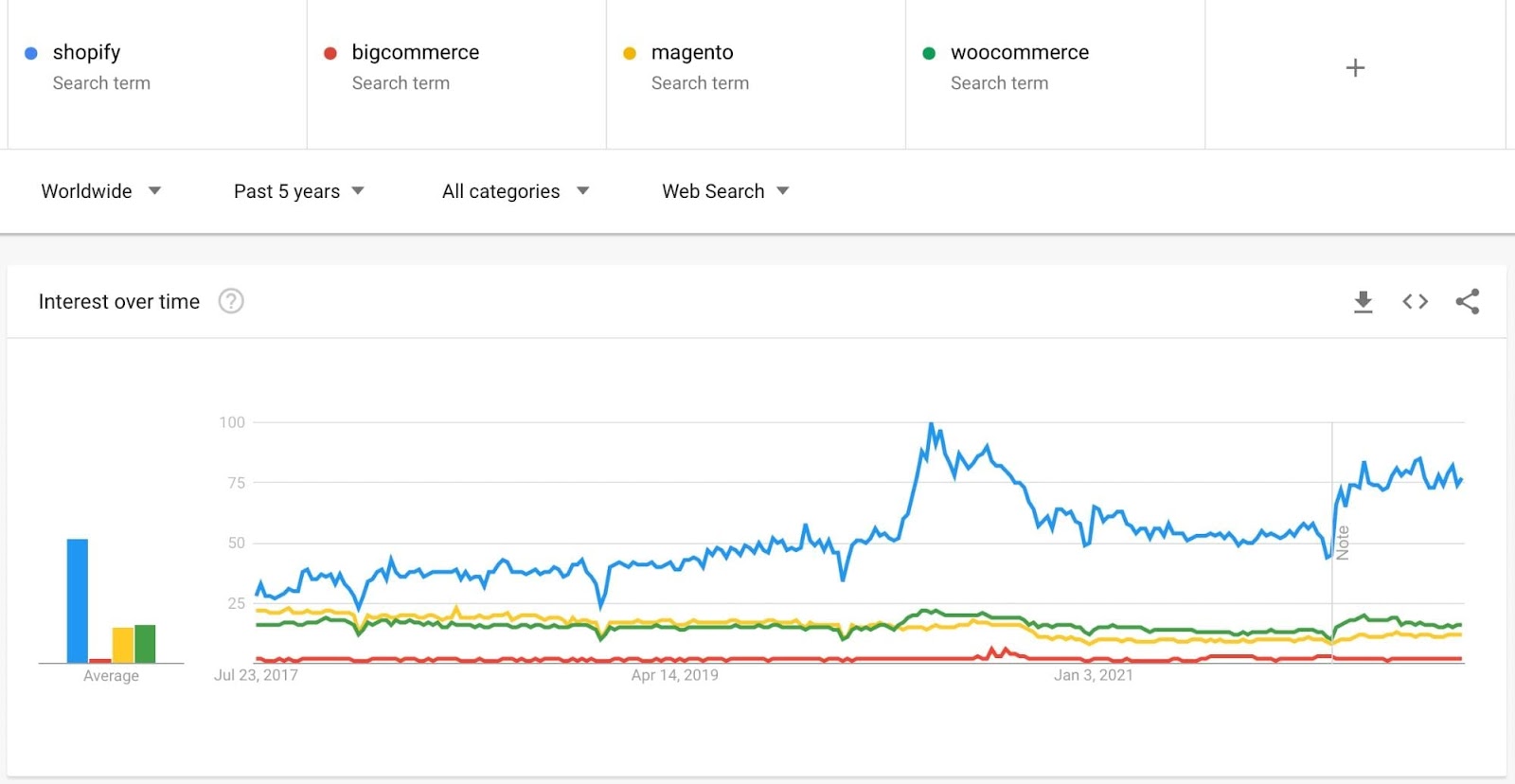
Let’s look at these big ecommerce platforms and how they could benefit your business.
#cta-paragraph-pb#Check out our roundup of the top tools that ecommerce brands can use to scale efficiently, including some of these top platforms.
Shopify – The most popular ecommerce platform
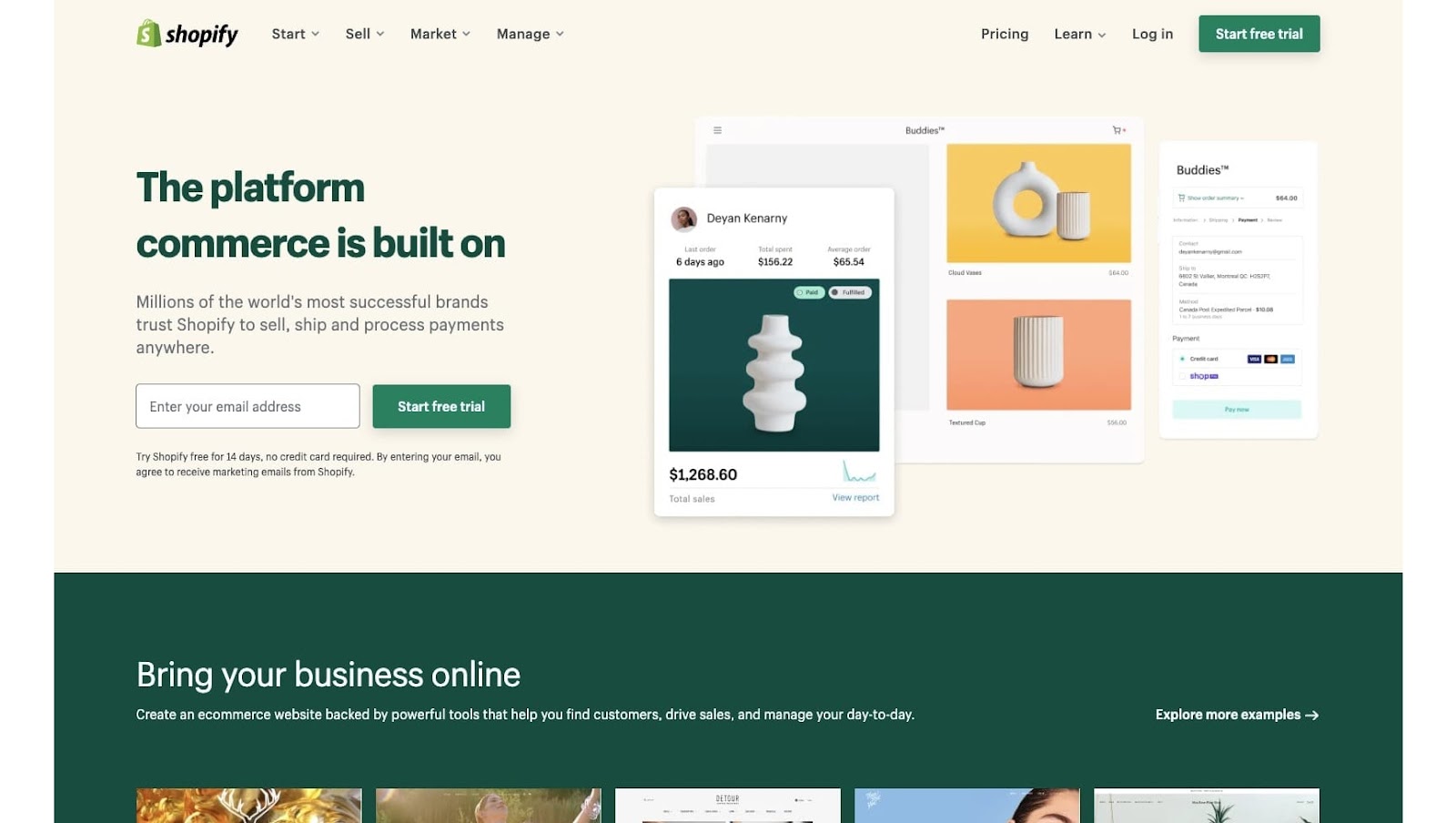
Shopify has quickly become the most popular ecommerce platform, with 1.75 million merchants calling it their home and many of the top ecommerce brands using it to sell their products.
The allure of Shopify is that it makes creating your own online store simple. Getting your store from idea to reality is quick with guided onboarding on the dashboard and help center.
Store design and functionality are significant considerations in a Shopify store, with lots of great-looking themes and thousands of powerful apps at your fingertips.
Best for:
- Small to medium-sized businesses
- Shopify Plus is excellent for scaling businesses up to enterprise level
Features:
- Hosting is included
- Quickly buy a custom domain
- Shopify’s theme editor for easy edits to page templates
- Over 8,000 apps store design, subscriptions, shipping, reviews, and more
- POS functionality for offline selling with inventory sync
- Shopify Payments for an easy payment solution at low cost and no transaction fees
- Shopify Shipping gives discounts of up to 88% of retail price
- Easy to add extra sales channels like marketplaces and social media platforms
Pricing:
- Basic – $29/mo
- Shopify – $79/mo
- Advanced – $299/mo
- Learn more in our guide to Shopify pricing plans
Fees:
- Payment processing fee: Between 2.4% and 2.9% plus 30¢ per transaction
- Transaction fee: Between 2% and 0.15%; waived with Shopify Payments
BigCommerce – A growing ecommerce platform for scaling stores
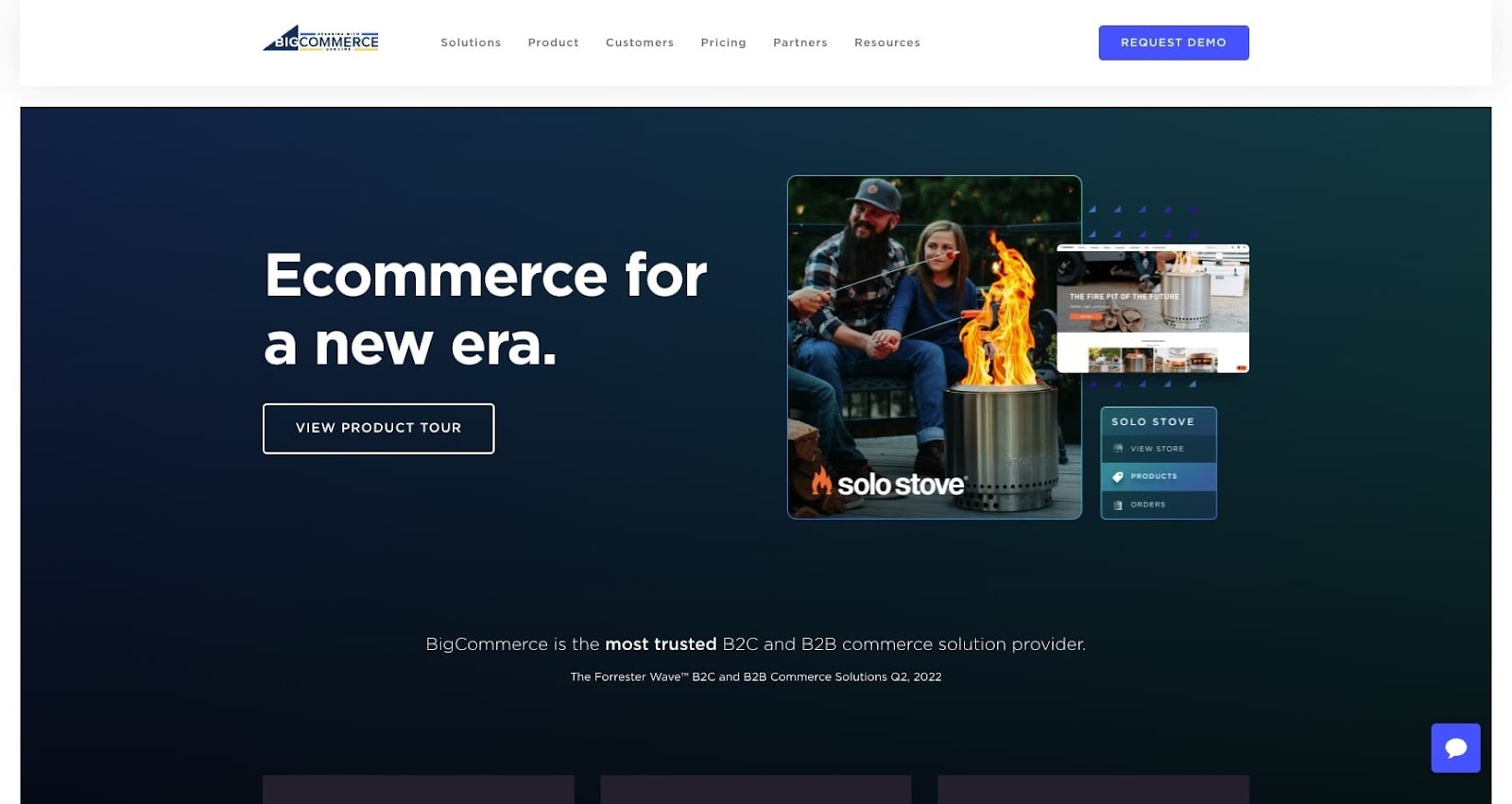
While BigCommerce has a smaller footprint, they are steadily growing its offering for the nearly 50,000 stores that use it.
Like Shopify, BigCommerce has lots of great themes and apps to make building and running your store easy and intuitive. The visual editor makes customization simple and allows for more in-depth customization with the help of developers.
The dashboard gives merchants easy access to everything they need to run and build their stores.
Best for:
- Solopreneurs and small businesses
- Medium to enterprise level businesses
Features:
- Comes with hosting out of the box
- Purchase a custom domain for your unique store
- Visual editor for quick changes to templates
- Lots of integrations for marketing, operations, shipping, etc.
- The ability to sell offline and online
- Multiple storefront capabilities for global expansion
- No transaction fees
- Works with both Shogun Page Builder and Frontend
Pricing:
- Standard – $29.95/mo
- Plus – 79.95/mo
- Pro – 299.95/mo
Fees:
- Credit card fee (if using Braintree): Between 2.05% and 2.59% and 49¢ per transaction
Adobe Commerce (formerly Magento) – The open source platform for large ecommerce businesses
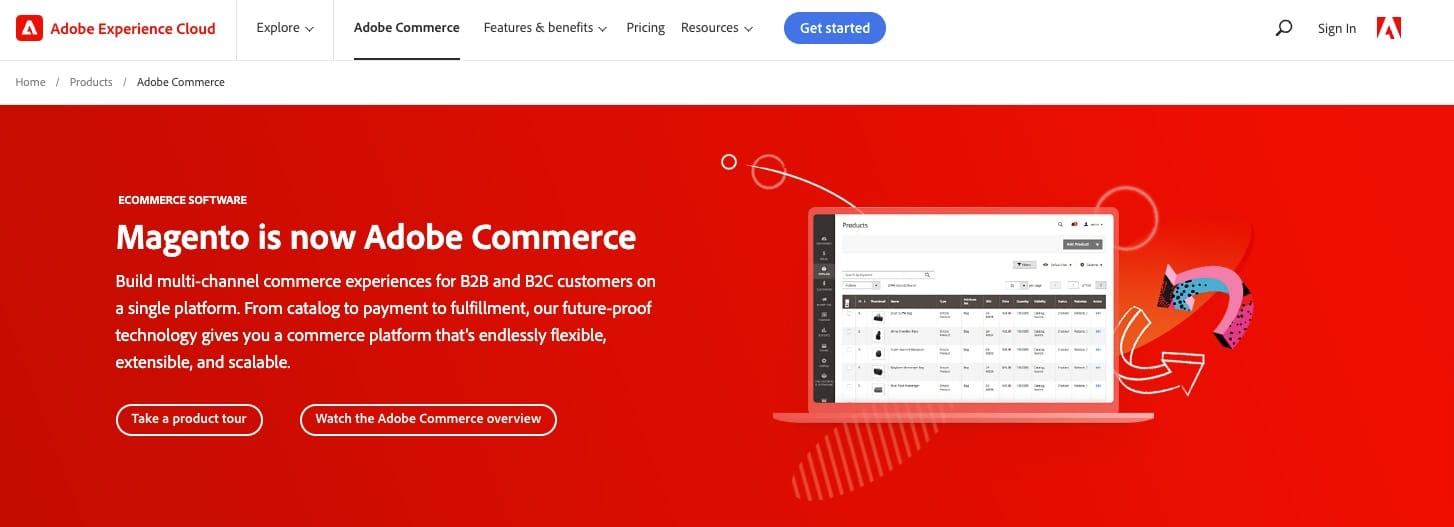
Formerly called Magento, Adobe Commerce is an open-source ecommerce platform that allows merchants to have total control over how their store looks and operates.
Unlike Shopify and BigCommerce, Adobe Commerce isn’t built for ecommerce beginners. It’s an extremely scalable platform, allowing brands to list hundreds of thousands of products and handle high shopping volumes easily.
While themes are available for purchase, the platform is best suited for brands working with development agencies to create completely custom stores.
Additionally, you must purchase hosting and security certificates separately to get your store up and running.
Best for:
- Medium-sized to enterprise-level businesses
Features:
- Drag and drop page builder for tweaking important pages
- Built for large catalogs and easy scalability
- PWA functionality to create custom mobile experiences
- Multi-store capabilities allow merchants to grow their brand globally
- AI-driven automation to improve customer navigation and cross-selling
- Go headless with Shogun Frontend for a stunning storefront experience
Pricing:
- Magento Open Source is free to install
- Adobe Commerce starts at $22,000 per year, based on gross sales revenue
- Adobe Commerce Cloud starts at $40,000 per year, based on gross sales revenue
- Extra costs for hosting, development, SSL, domain, extensions, development, etc
Fees:
- Payment processing fee: 2.9% and 30¢ per transaction
WooCommerce – The most popular open source ecommerce platform

WooCommerce is WordPress’ answer to ecommerce functionality. For those that start with a WordPress site, WooCommerce is the simplest way to spin it out into a storefront.
It’s another open-source platform, like Adobe Commerce, which requires your own hosting solution and development. While building your store on your own isn’t easy, you can make your store look totally unique with development help.
Plus, there are tons of extensions and plugins for WooCommerce and WordPress that help brands build their perfect store and blog.
Best for:
- Small to medium-sized businesses
- Enterprise level businesses
Features:
- Scalable, developer-friendly platform
- WooCommerce Experts program to find great developers
- Lots of secure payment gateway options
- Free and paid extensions to customize your store operations
- Go global with multiple currencies and languages
- No cost to install and no transaction fees
- Blogging capabilities make content marketing easy
Pricing:
- Free to install
- Extra costs in the form of hosting, SSL, extensions, development, and domain
Fees:
- Payment processing fee: 2.9% and 30¢ per transaction
#cta-visual-pb#<cta-title>Build awesome Shopify & BigCommerce stores<cta-title>DIY your store design with the best page builder tool by creating stunning store pages and landing pages that drive conversions.Get started today
Marketplaces are great for getting sales quickly since you don’t need to spend time building an audience. The traffic is already there, so you can get noticed right away and start building revenue.
While you don’t get access to your customers directly, you can build brand awareness that can hopefully translate into your own ecommerce store (i.e., one of the platforms above).
Let’s look at the biggest marketplaces and how they can boost your online presence.
Amazon – The biggest online marketplace
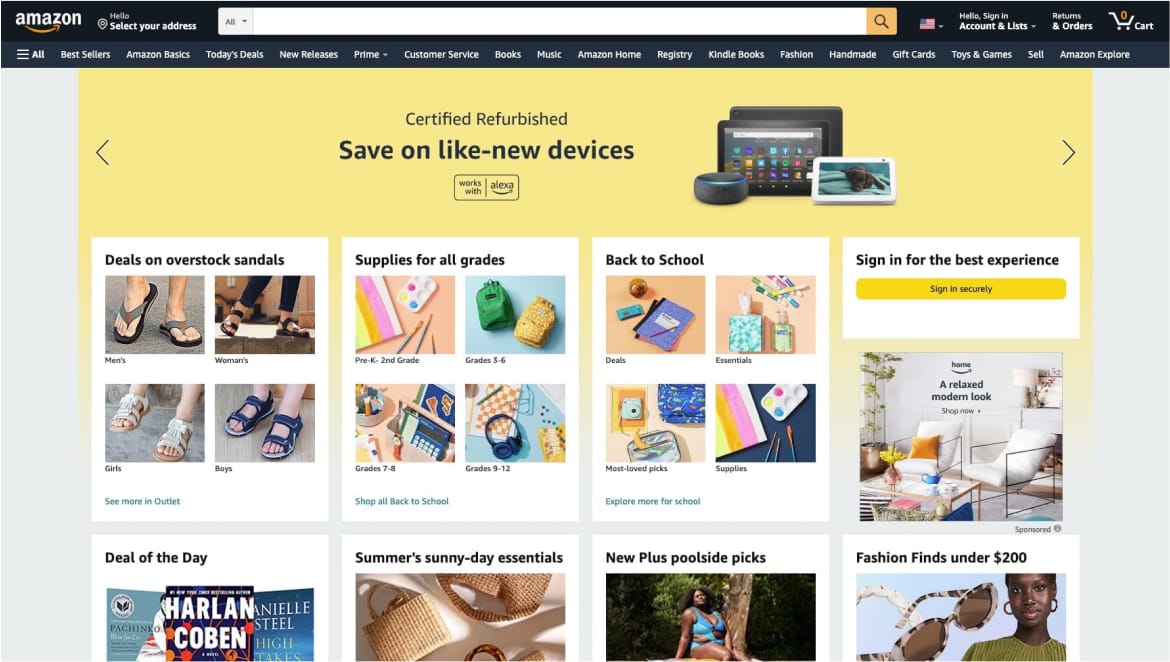
The largest marketplace in the world is Amazon, by a mile. They sell everything from books and apparel to electronics and home goods.
While Amazon itself sells many of the products listed, there are over six million third-party sellers on the marketplace. With more than 2.45 billion monthly visits to the site, these sellers enjoy a huge trove of potential customers just by getting on Amazon.
Assuming your listings are optimized for Amazon’s algorithm, there is little marketing you have to do to start seeing sales.
You can use their CPC ads to boost listings in search, but sellers have little to no direct relationship with their customers on Amazon.
Best for:
- Small businesses (as a primary sales channel)
- Medium to enterprise businesses (as an extra sales channel)
Features:
- The largest customer base with high purchase intent
- Get lots of product reviews quickly
- Create Amazon storefronts unique to your brand
- Marketing tools and A/B testing to optimize for sales
- Brand analytics give insights into business decisions
- Use advertising tools to increase reach
- Fulfillment by Amazon handles your 2-day Prime shipping
Pricing:
- Individual – $0.99 per item sold
- Professional – $39.99/mo
Fees:
- Referral fee: Between 8% and 20% of sale; minimum of 30¢
- Fulfillment fees for FBA based on product and packaging
- Miscellaneous fees for storing inventory, returns, high-volume listing, ads, etc.
Walmart Marketplace – The largest omnichannel retailer

Walmart has been in retail for more than 50 years, becoming one of the largest retailers in the world. It is now the second largest ecommerce retailer after Amazon and is the largest company in the world by revenue.
With Walmart Marketplace, they opened up their massive online platform to third-party sellers.
Products from these merchants show up on Walmart.com with every other product, and brands can choose to fulfill themselves or use Walmart Fulfillment Services to ship orders.
The only cost is a referral fee based on the product type, and you can easily add Walmart as an extra sales channel for your main ecommerce store.
Best for:
- Small businesses (as a primary sales channel)
- Medium to enterprise businesses (as an extra sales channel)
Features:
- Large built-in audience ready to buy
- In-store and online return services
- Listing Quality Dashboard for optimizing product listings
- Free TwoDay and ThreeDay is Walmart’s answer to Amazon Prime shipping
- Walmart Fulfillment Services (WFS) can handle your shipping
Pricing:
- Free to join and list
Fees:
- Referral fee: Between 6% and 20% of the sale
- Extra costs if using Walmart Fulfillment Services (WFS)
Etsy – The go-to marketplace for handmade products
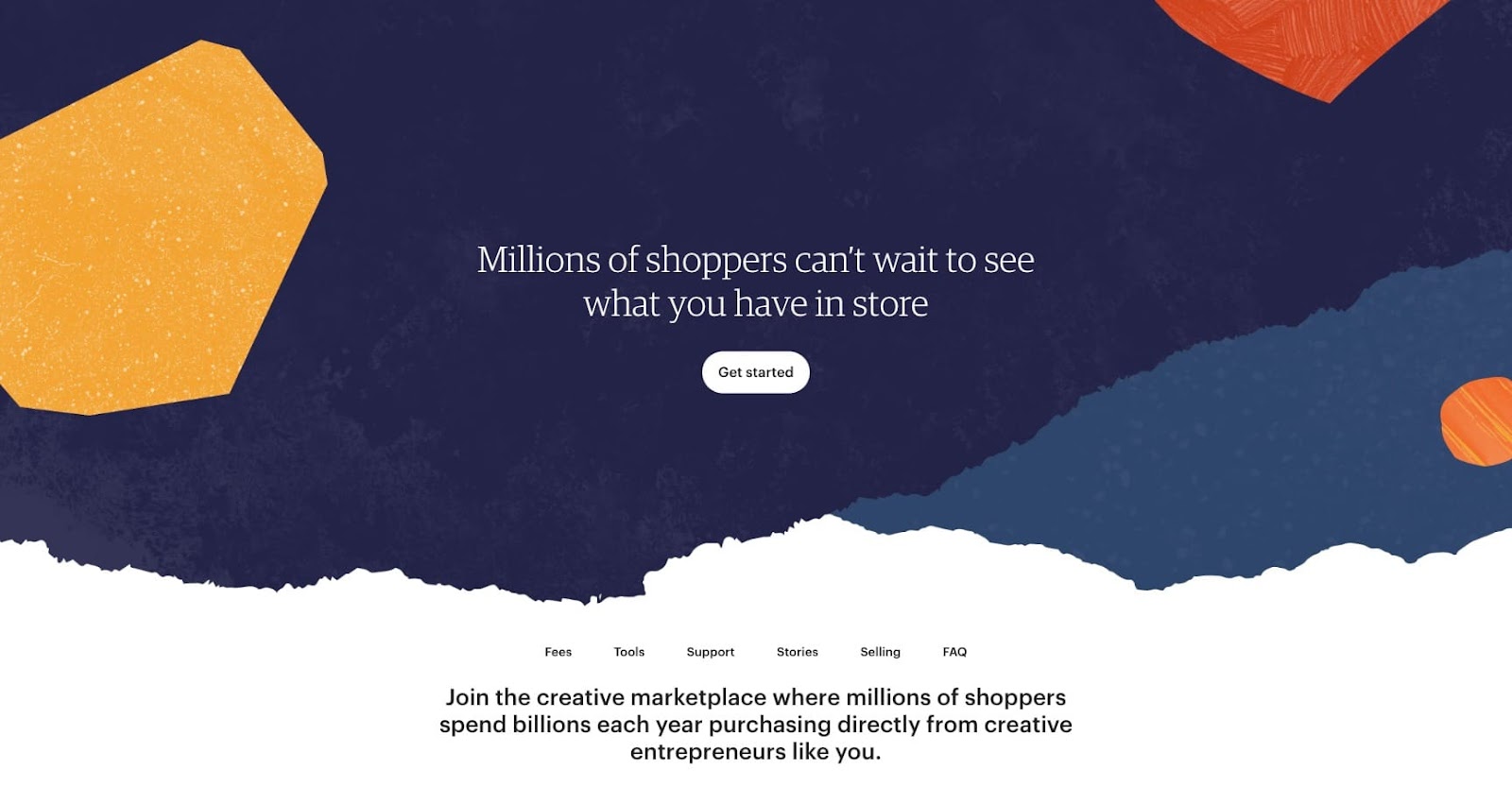
Etsy has been around for more than 17 years and is well known for being the place to buy vintage and handmade items.
They have a massive audience of customers that sellers can access immediately after listing. Small ecommerce businesses can quickly add products and optimize listings to appear in search results.
Marketing is simple with built-in tools and the option to advertise on and off of the marketplace.
While you don’t have direct access to customers, Etsy takes care of that relationship, freeing up your time for other things.
See how Etsy compares to Shopify to understand better how marketplaces and platforms differ.
Best for:
- Solopreneurs and small businesses selling handmade or vintage items
Features:
- Built-in audience for handmade items
- Option to create a standalone storefront with Pattern
- Etsy Seller App for easy store management
- Shipping discounts through Etsy
- Advertising tools
- Ability to run sales
- Back-in-stock notifications (Etsy Plus)
Pricing:
- No monthly cost for the regular plan
- Etsy Plus – $10/mo
- Etsy Pattern (standalone storefront) – Additional $15/mo
Fees:
- Listing fee: 20¢ per listing
- Transaction fee: 6.5% of total item cost
- Payment processing fee: 3% plus 25¢ per transaction
eBay – A huge online marketplace with auction capabilities

One of the oldest online marketplaces, eBay got its start in 1995 as AuctionWeb. They hosted online auctions where buyers bid against each other for various items, however random and esoteric.
The auction element remains to this day, but sellers can also sell at fixed prices for more straightforward transactions. They are now a global marketplace with 142 million buyers in 190 markets.
Their product categories run the gamut from apparel, art, and electronics all the way up to prefab buildings and heavy equipment.
Small businesses get access to selling tools like inventory management, market research, marketing tools, and shipping discounts.
Best for:
- Solopreneurs and small businesses
- Individuals clearing out their stuff
Features:
- A large audience of potential customers
- Community forums for sellers
- Bulk listing tool
- Negotiated shipping rates
- Terapeak research tool
Pricing:
- Free to join for casual sellers
- Starter – 4.95/mo
- Basic – 21.95/mo
- Premium – 59.95/mo
- Anchor – 299.95/mo
- Enterprise – 2,999.95
Fees:
- Insertion fee: First 250 listings free per month, then 35¢ per listing
- Final value fee: Between ~10-15% plus 30¢ per order
- Miscellaneous fees for listing upgrades
Bonanza – The up and coming marketplace with lower fees

Think of Bonanza as a virtual mall full of little shops selling everything from fashion and home goods to jewelry and art. In the spirit of a mall, merchant profiles are actually referred to as ‘booths.’
Just like other marketplaces, buyers find products by searching and through ads. Sellers need to optimize their listings for search and can opt into Bonanza’s ad program, which leverages Google Shopping.
Whereas most marketplaces keep customer data secret from sellers, Bonanza gives their merchants this info in their Customer Marketing Tool.
Best for:
- Solopreneurs and small businesses
- Individuals clearing out their stuff
Features:
- No listing fees
- Low selling fee structure
- Access to customer information
- Google Shopping ads
- Premium membership tiers for increased page views
Pricing:
- Free to join
Fees:
- Base fee: 3.5% of Final Offer Value (additional 1.5% for FOV of $1,000+)
- Optional Google Shopping Ads fee between 9%-30%
Where you choose to sell your products may well depend on what types of products you sell. For secondhand, antique, and collectible items, that’s very true.
Certain sites are made just for selling things that aren’t brand new. And the shoppers are there to find some gently used items to buy.
Here are a few great sites for selling your secondhand products to a ready audience.
Poshmark – Sell your secondhand clothing
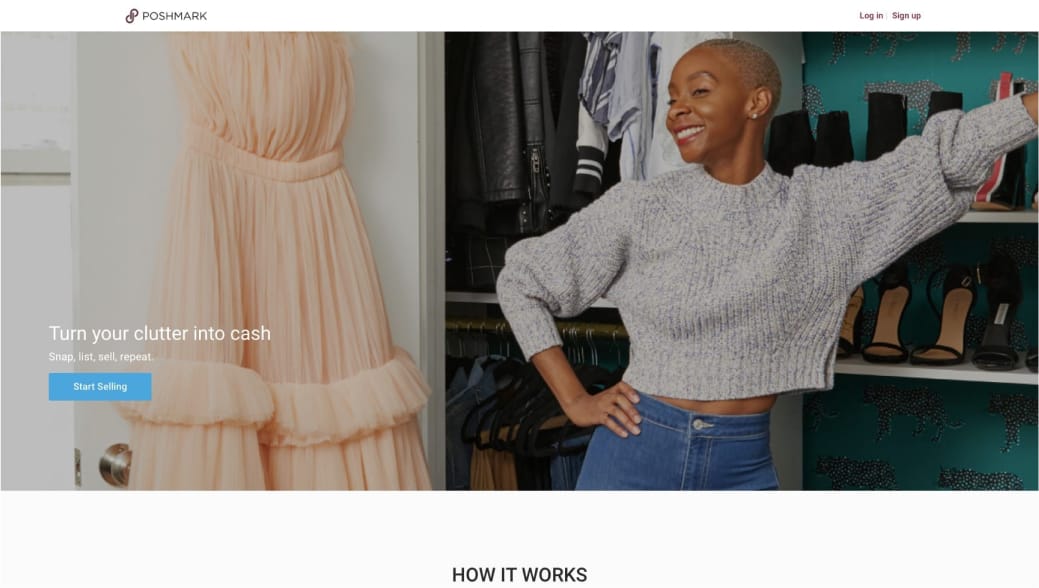
For secondhand apparel and accessories, Poshmark is among the top marketplaces you’ll find.
Their mobile app makes it easy to quickly post new pieces of clothing to your ‘closet’ and share it on the platform. It operates much like a social network, where you interact with potential buyers as they comment on your listings.
Sellers can even join real-time shopping events called Posh Parties to sell pieces to engaged customers actively.
Best for:
- Small merchants selling secondhand clothing
- Individuals selling their old clothes
Pricing:
- Free to join
Fees:
- Final order price fee: $2.95 for sales under $15; 20% for sales above $15
Swappa – Sell your secondhand electronics

For selling your secondhand electronics, Swappa is an easy choice. The categories include mobile phones, laptops, watches, gaming consoles, cameras, and more.
Their selling costs are minimal, with the buyer and seller sharing the fee. This makes them a better choice than eBay for selling electronics .
The process is simple and safe for both parties, and high-volume sellers can access additional tools to manage their listings.
Best for:
- Small merchants selling secondhand tech products
- Individuals selling household tech products
Pricing:
- Free to join
Fees:
- Seller fee: 3%
- Buyer fee: 3% charged to the customer
Ruby Lane – Sell vintage and antique items
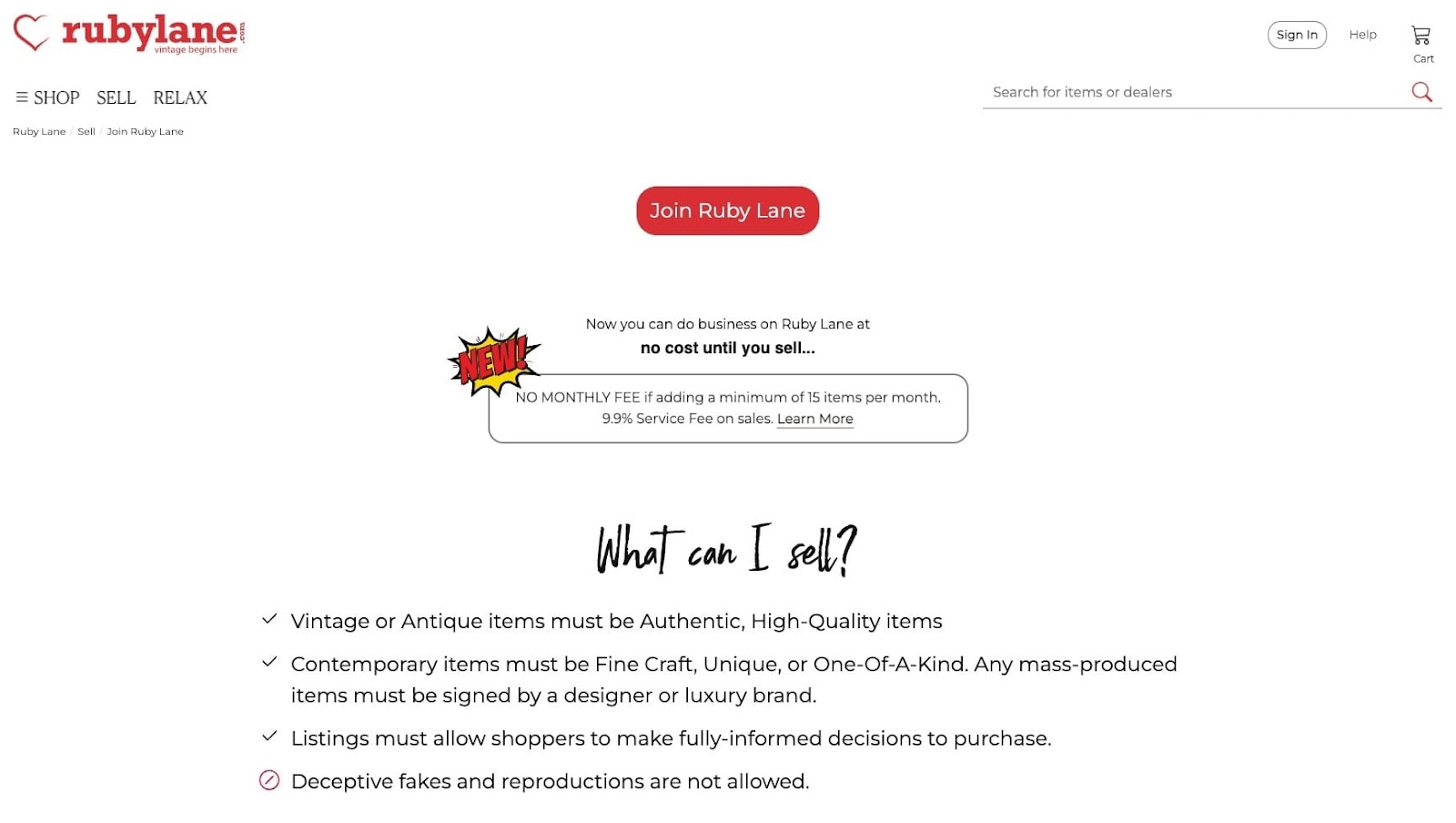
The most lauded types of secondhand items are those that are antique or vintage.
Ruby Lane focuses on just this type of unique product, with rules in place to make sure all listed items fit the bill.
They have just a handful of product categories, which include collectibles, dolls, jewelry, porcelain, furniture, and fashion.
Sellers can list for free and only pay a fee when they’ve made a sale.
Best for:
- Small merchants selling vintage and antique products
Pricing:
- Free to join
Fees:
- Maintenance fee: $25/mo (get a full rebate for adding 15 items each month)
- Service fee: 9.9% of the purchase order total (not including sales tax); capped at $250
Many businesses are well past the point of selling on local marketplaces, but they are still active and viable services for selling something that is just going across town.
When you want to sell your extra stuff but don’t want to deal with shipping it, you can do it quickly with websites like Facebook Marketplace, Craigslist, and a few other options. Let’s take a look.
Facebook Marketplace – Sell locally to a large audience

Facebook isn’t just for reminders of old high school friends’ birthdays and keeping updated on your grandma’s social life. You can also buy and sell items.
There are two ways to do it: Facebook Marketplace and Facebook Shops. For our purposes, we’ll cover the more community-focused Facebook Marketplace.
You can sell items within a certain distance from your home and even add shipping.
Listing items is free, but there are small fees on each sale.
Best for:
- Individuals selling their old stuff locally
Pricing:
- Free to join and list
Fees:
- For sales of $8 or less: 40¢
- For sales over $8: 5% of the sale
Craigslist – The original free local online selling site
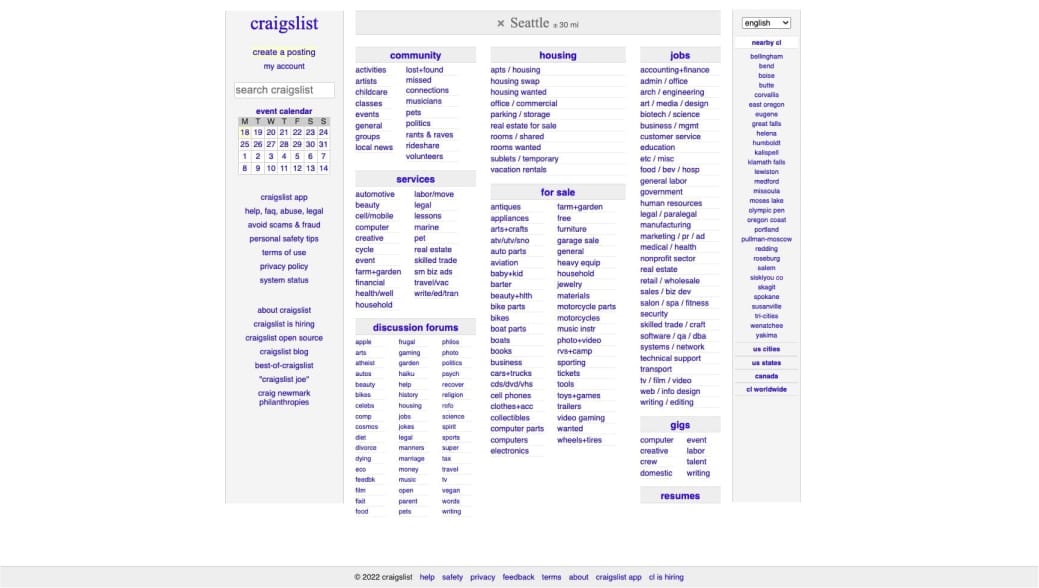
The most classic site for buying and selling locally, Craigslist looks the same as it did when it debuted in 1996.
It couldn’t be easier to find what you need, even if the site looks like a poorly designed spreadsheet.
You canbuy and sell just about anything on Craigslist, from cars and furniture to toys and electronics. Of course, you can also find housing, jobs, services, community gossip, and more.
While there are fees for certain categories of products, the vast majority of listings are free.
Best for:
- Individuals selling their old stuff locally
Pricing:
- Free to join and list
Fees:
- Certain listings have fees, such as vehicles and by-dealer categories
VarageSale – Sell in local communities for free

Sometimes a name says it all. VarageSale is your virtual garage sale, making it easy to sell within your community.
When you join, you have to find your community and get approved by the admins of that community before buying or selling.
Sell your shoes, home decor items, grill, whatever—all for free.
Best for:
- Individuals selling their old stuff locally
Pricing:
- Free to use
Fees:
- No fees
Nextdoor – Sell within your neighborhood for free
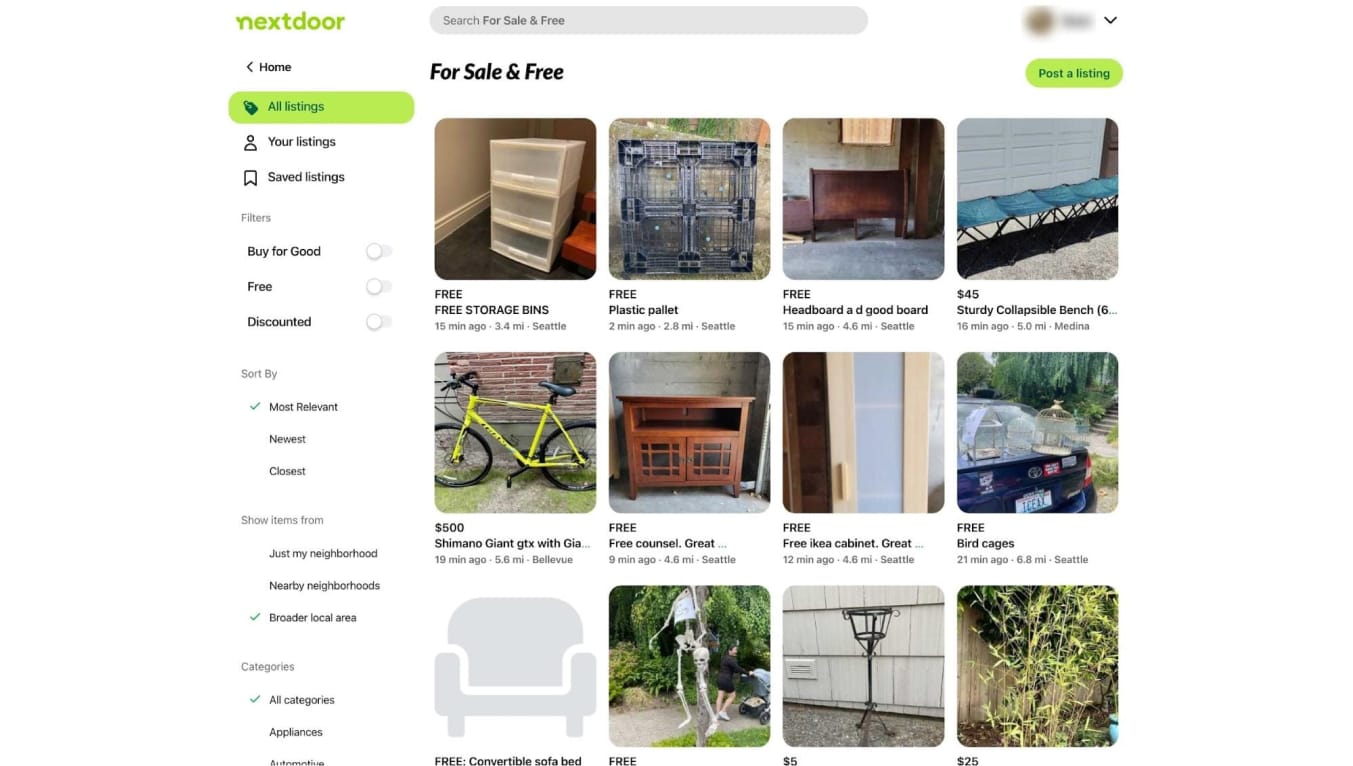
While not your traditional sales platform, Nextdoor does offer the ability to buy and sell to your neighbors.
So, you can sell your stuff while also learning about the latest coyote sightings in your hood.
People can post an item to sell as simply as any other post on Nextdoor. Just add the info and images for your item, set the pricing, choose who gets to see it, and post. You can also give items away for free.
Selling on Nextdoor is totally free.
Best for:
- Individuals selling their old stuff locally
Pricing:
- Free to join and list
Fees:
- No fees
OfferUp – Sell locally for free
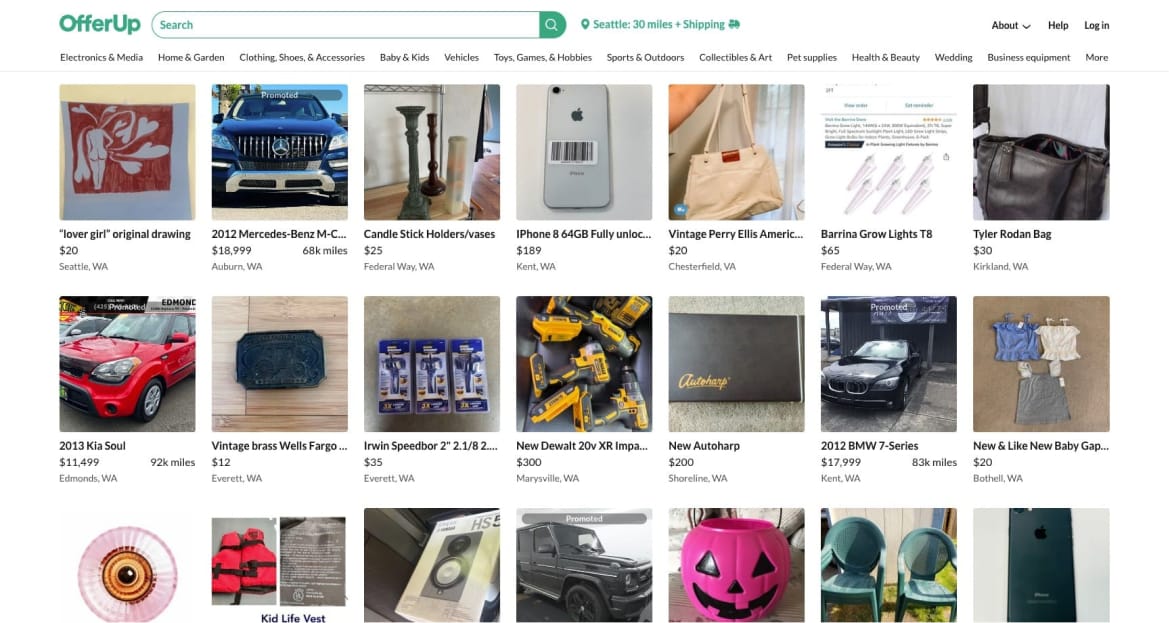
OfferUp is a super simple platform that makes buying and selling items nearby super easy.
Sellers can post their items in seconds from the mobile app and can sell anything from electronics and apparel to vehicles and pet supplies.
It’s completely free to use though you can pay to promote posts or for shipping.
Best for:
- Individuals selling their stuff locally
Pricing:
- Free to join and list
Fees:
- If shipping an item, the service fee is either a minimum of $1.99 or 12.9% of the sale price
Find your perfect platforms and start selling
There isn’t one perfect online selling site for merchants. It all depends on who you are, what you are selling, and your growth goals.
Local marketplaces will do the trick for those just clearing out their house during Spring cleaning. They are cheap, simple, and make getting the items to the buyer super low effort.
For brands just getting started, it makes sense to build up brand awareness and quick revenue with online marketplaces. You can create your own storefront and control your customer relationships as you grow.
For scaling brands, your best bet is to start with an ecommerce platform and go multi-channel with popular marketplaces to expand your reach and grow your revenue stream.
Whatever you choose, it’s essential to understand the costs and benefits of each. Happy selling!
#cta-visual-pb#<cta-title>Customize your store the easy way<cta-title>Create stunning store pages and landing pages that drive conversions by using Shogun Page Builder, your go-to no-code solution for page building.Start designing today

Sean Flannigan
Sean is one of Shogun's tireless content marketers. When he isn't creating exciting ecommerce content, he's probably biking or at the park.



